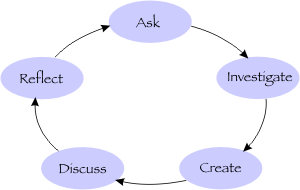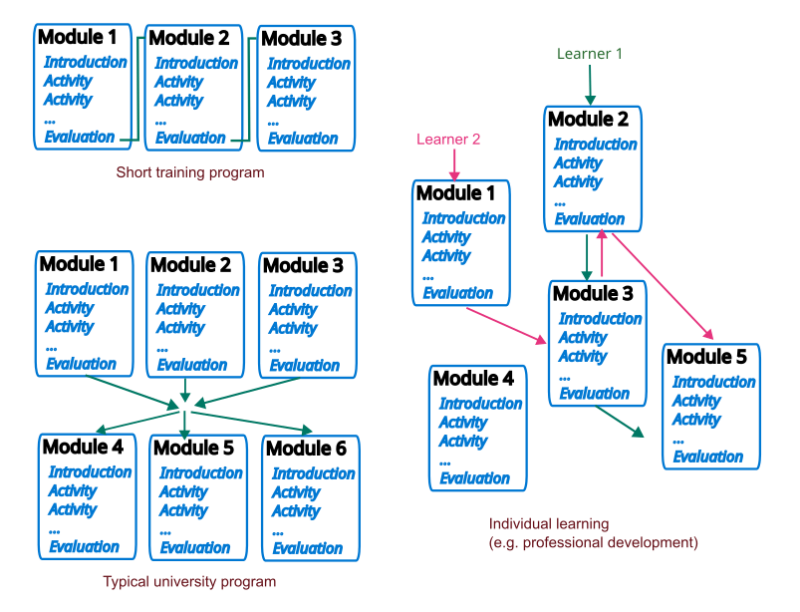Program design and implementation (CAS HEiE) - week 4
DKS:Program design and implementation (CAS HEiE)
Week 4 - Course design and activity design
- Interactive Class: Monday November 7: 17h30 (!!!) - 19h30
- Interactive Class: Wednesday November 9: 16h00 - 18h15
- Public tutoring session: Friday November 11: 16h-18h
We shall re-discuss and re-use some module 2 topics (B. Class) and intensify project work.
What is learning and teaching ?
Recall of some principles:
- Instructional design method made simple: Define goals, define how to evaluate learning, design, implement
- First principle of learning: Learners must be active
- First principle of teaching: Structure the learning experience so that learners engage in learning activities and monitor learning activities
- Fit course design to learning types and levels: Different learning types require different strategies, beginners may need more direct instruction than advanced learners
- Choose the right learning materials: Online and offline textbooks, (interactive) multimedia presentations, computer-supported collaborative activities, computer-based learning tools (exercising, simulations, serious games, etc.)
- Relationship between learning activities, tutoring and learning materials: You can "build" teaching functionality into learning materials, however this is costly and removes flexibility. Any classes should be tutored in one way or another (by a teacher, tutors, or peer tutoring).
- Alignment principle: Learning goals, evaluation strategies and teaching/learning activities must be aligned.
Defining a course structure and organization
A program needs
- a vision that defines general learning outcomes (e.g. become an active citizen) and a fitting global pedagogic strategy
- a set of subject-area specific global learning outcomes (or competences) that typical learners should achieve
- an infrastructure
- a course structure (including external courses that students can take)
Major types of course structures
In terms of planning we can distinguish macro, meso and micro level.
| Macro
= global learning outcomes & global modularization |
|
||
|---|---|---|---|
| Meso
= course modularization |
|
||
| Micro
= pedagogic scenarization (learning design) |
|
A program can be organized in different ways.
- In a full program, learners typically do between 3 and 10 course in parallel (in the EU in two to eight semesters). In continuous training, a course is taken one after each other. In individualized learning, paths through courses can be adapted to each learner. In addition or alternatively it can be driven by a competency framework.
Discussion:
- What are advantages of standardized programs vs. programs with many choices ?
- Advantages of individual learning paths vs. learning in cohorts ?
- Did any of you experience self-study programs ?
Modes of delivery
- Classic distance teaching with online or offline tutoring,
- Online tele-teaching,
- Online or offline self-learning,
- Blended learning,
- Classroom learning with some distance component (e.g. flipped classrooms, substantial homework)
- Mixed blended, online learning (e.g. one cohort is present, another at distance)
- Classroom learning with some homework
- .....
Activity structures
Learner support and follow-up
- Any good program should implement a tutoring system,
- have a technical infrastructure that supports follow-up (e.g. track student present, assignments, gradebooks)
Learner evaluation models
Formative vs. summative evaluation
A course design should include both formative and summative evaluation:
- Formative evaluation provides feedback to the learner that allows him/her to correct action and progress. In case of failure, you can suggest corrective action.
- Summative evaluation evaluates and grades the state of knowledge with respect to defined learning goals.
You can both at the same time.
In addition, strategic evaluation can precede (what are the needs) or follow (e.g. do learners find jobs) ?
Alignment
Assessment strategy must be aligned with learning goals and learning activities.
- E.g. if the learning goal is acquire applicable skills and the learning activity project-oriented, you must evaluate the project
Program-level decisions
- Each class can define different ways to evaluate students. However, some principles (e.g. using the same grading scale) should be shared. Mass education programs are usually more automatized, therefore most elements should be shared.
- Avoid administering only final exams only in distance education, since many students will not be prepared. In larger classes without strong tutoring, organize at least a mid-term exam plus regular self-evaluation quizzes
Pedagogic strategies
Pedagogic design should be discussed at both program and course level.
- There should be some common principles
- However, different course may address different types of learning and learning levels and will be different.
Models for Instructional designs
There exist many popular pedagogic strategies. Some include models that define learning sequences.
Direct instruction - 9 events of instruction
Gagnés (1974) [1] nine events of instruction still set the gold standard for "traditional" teaching. It can be applied to both classroom and online teaching.
- Gain attention (ground the lesson, motivate)P
- Present a good problem, a new situation, use a multimedia advertisement, ask questions…
- Describe the goal (frame the information, create expectancies)
- State what will be accomplished, how knowledge can be used, give a demonstration,...
- Stimulate recall of prior knowledge (help connecting)
- … facts, rules, procedures or skills relevant to the current lesson ….
- Present the material to be learned
- e.g. text, graphics, simulations, figures, pictures, sound, etc. Chunk information
- Provide guidance for learning
- Presentation of content is different from instructions on how to learn. Use of different channel (e.g. side-boxes)
- Elicit performance "practice"
- Let the learner do something with the knowledge, practice skills or apply knowledge. At least use MCQ's.
- Provide informative feedback ,
- show correctness of the trainee's response, analyze learner's behavior, maybe present a good (step-by-step) solution of the problem
- Assess performance, test if the lesson has been learned.
- Also provide general progress information
- Enhance retention and transfer :
- e.g. inform the learner about similar problem situations, provide additional practice. Put the learner in a transfer situation...
Project-based learning
Inquiry learning

from: [The Inquiry Page]
4C/ID
4C/ID is an ambitious instructional design model that attempts to combine project-based learning with direct instruction.
Communal constructivism
Learning design
- Learning design defines an educational sequence (also called scenario, script, activity sequence, ...)
- The exist some planning tools (laerning design tools, lesson planners, etc)
- Learning design should follow usability principles (clear instructions, clear evaluation criteria, etc.). For new types of activities training and onboarding may be required.
Worksheets
In particular novice teachers are encouraged to use some activity planning tool to design learning sequences. Simple worksheets that define the following points can do:
- Learning goals
- Resources
- Tools
- A list of activities. Each activity
- defines which tasks learners do using what tools and resources
- has a duration
- Some of these task can be collaborative or collective.
- Should lead to an output (some can be used in further activities, some is graded)
Module 3 project
(details to be announced on Wednesday)
- Complete the program design form
- Check that all sample activities in your Moodle class are done
- ↑ Gagné, R. M. (1974). Essentials of learning for instruction. (2nd ed.). Hinsdale, IL: The Dryden Press.
